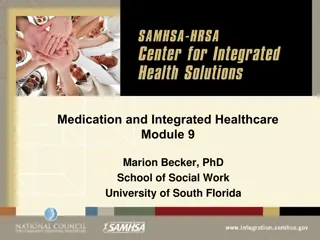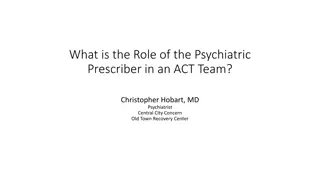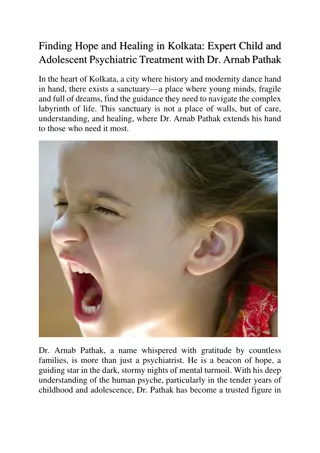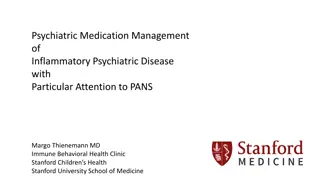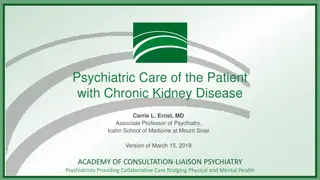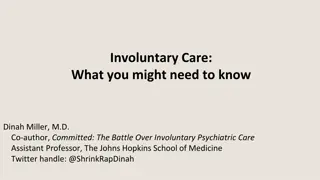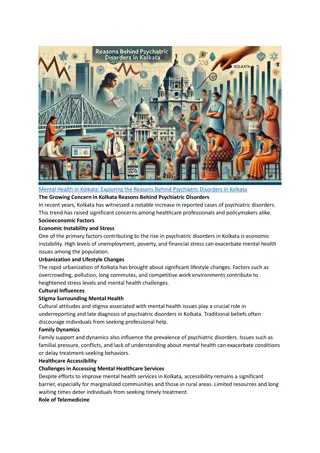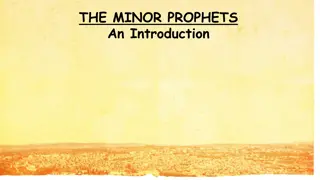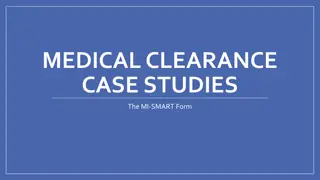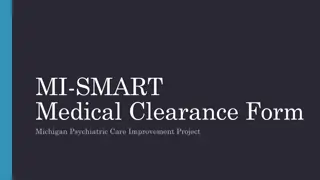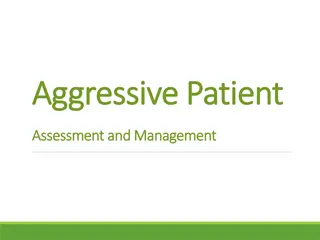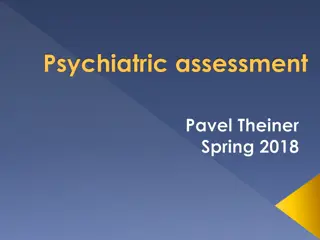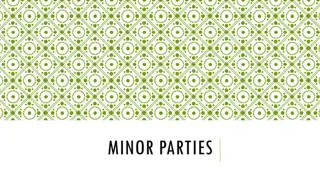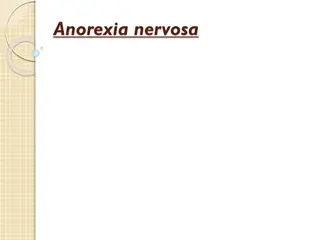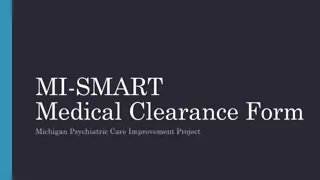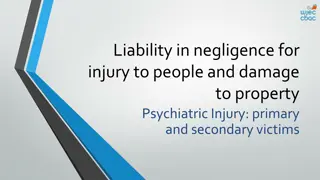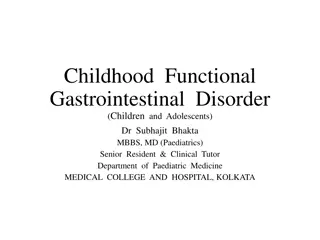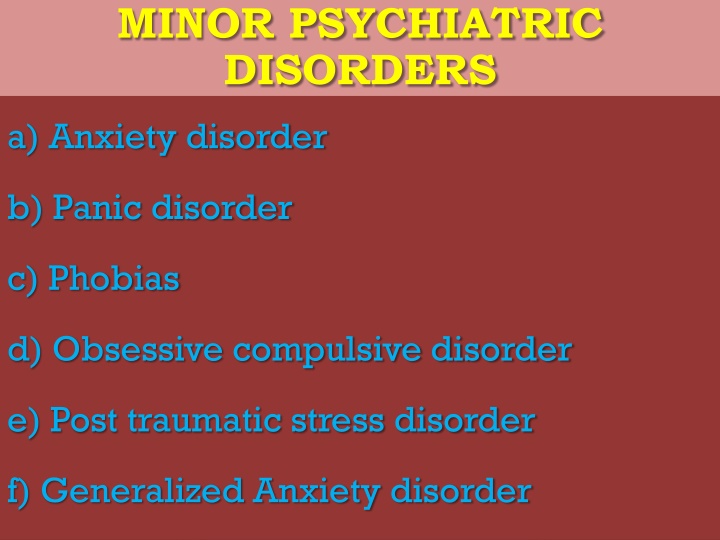
Minor Psychiatric Disorders: Anxiety, Panic, Phobias, OCD & More
Explore the characteristics, causes, and symptoms of minor psychiatric disorders such as anxiety, panic, phobias, obsessive-compulsive disorder, and post-traumatic stress disorder. Learn about normal vs. pathological anxiety and factors contributing to these disorders.
Download Presentation

Please find below an Image/Link to download the presentation.
The content on the website is provided AS IS for your information and personal use only. It may not be sold, licensed, or shared on other websites without obtaining consent from the author. If you encounter any issues during the download, it is possible that the publisher has removed the file from their server.
You are allowed to download the files provided on this website for personal or commercial use, subject to the condition that they are used lawfully. All files are the property of their respective owners.
The content on the website is provided AS IS for your information and personal use only. It may not be sold, licensed, or shared on other websites without obtaining consent from the author.
E N D
Presentation Transcript
MINOR PSYCHIATRIC DISORDERS a) Anxiety disorder b) Panic disorder c) Phobias d) Obsessive compulsive disorder e) Post traumatic stress disorder f) Generalized Anxiety disorder
Anxiety Disorders Anxiety is a normal response to stressors, pathological if it becomes so exaggerated, frequent and chronic that it impairs normal functioning of person Anxiety is the main feature of anxiety disorders Anxiety = a state consisting of psychological and physical symptoms brought about by a sense of apprehension at a perceived threat Perceived threat can be many external like agoraphobia (wide spaces), social phobia and specific phobias OR internal as in panic disorder, generalized anxiety disorder (GAD) and OCD
Normal Anxiety Known problem e.g. Exam, football match Definable, perception of external threat of some sort Lasts a short period of time If mild: helpful, If severe: harmful What is Pathological/clinical Anxiety? Sense of fear Not well defined Threat not immediate/ unknown May be an internal threat Often chronic
Pathological Anxiety Secondary to other psychiatric illnesses e.g. Psychotic and worried about being stabbed Secondary to physical conditions e.g. drug use (caffeine), drug withdrawal, hypoglycemia and alcohol Anxiety disorders Personality traits Childhood factors (loss/separation, abuse) Stress: relationships Social supports: families, less social support = more anxiety Genetic/biological factors
Onset early adulthood generally, rarely in middle age May be misdiagnosed as a depressive or medical disorder Female 2:1 Male Depressive symptoms are common in anxiety disorders and vice versa If the diagnostic criteria for depressive disorder and generalized anxiety disorder(GAD) are fulfilled = diagnosis of MIXED ANXIETY AND DEPRESSIVE DISORDER Other psychiatric disorders are also common in anxiety disorders, i.e. personality disorders and substance misuse
Symptoms of Anxiety- Psychological symptoms: feelings of fear or impending doom, apprehension Dizziness and faintness Restlessness Exaggerated frightened response Poor concentration Irritability Insomnia
Symptoms of Anxiety- Psychological symptoms: - cont. Night terrors Depersonalization Derealization Globus hystericus (lump in throat gulp) Themes of misfortune Belief of inability to cope with stress Unrealistic ideas of danger
Physical Symptoms Cardiovascular: palpitations, chest discomfort Dry mouth, lump in throat, nausea, abdominal discomfort, diarrhea Hyperventilation, difficulty catching breath, chest tightness Urinary frequency, failure of erection Other: hot flushes/cold chills, vibration, sweating, headache and muscle pains, numbness and itchy sensations around the mouth and in the boundary, dizziness and faintness
Anxiety disorders: Phobic anxiety disorders: agoraphobia, social phobias, specific phobias Panic disorder GAD - generalized anxiety disorder OCD obsessive compulsive disorder PTSD post traumatic stress disorder
Etiology Psychiatric and medical conditions: Psychiatric - Mood disorders, Psychotic disorders, Somatoform disorders and Eating disorders. Medical- hyperthyroidism, hypoglycemia and drug/alcohol intoxication/withdrawal Genetic Factors: inclination to anxiety disorders, noticeable neurotic traits or personality disorders Neuro-chemical abnormalities
Etiology Environmental factors: triggered by stressful events, especially those involving a threat. Can result from stressful/traumatic events in childhood Psychological theories:inappropriate thoughts processing. Psychoanalytical theory loss or separation in childhood.
Phobic Anxiety Disorders persistent, irrational fear that is usually recognized as such which produces anticipatory anxiety for and avoidance of the feared object, activity or situation Exposure to the feared thing provokes intense anxiety and even panic attack Types of Phobia Agoraphobia Social phobia Specific phobias:
Agoraphobia Agoraphobia is an anxiety disorder that causes intense fear of becoming overwhelmed or unable to escape or get help. Because of fear and anxiety, people with agoraphobia often avoid new places and unfamiliar situations, such as: Open or enclosed spaces. Crowds. Places outside your home. Public transportation.
Social phobia Extreme persistent fear of being judged and embarrassed/ humiliated in all/specific social situations. Specific phobias: fear of a specific object/location. Commonly enclosed spaces (claustro-), heights (acro-), darkness (achluo-), blood (haemato-).
Panic Disorder A discrete episode of intense fear or rapid onset of severe anxiety lasting 20-30 min. Recurrent and unexpected (no specific stimulus) reaching peak severity within 10 min Can also occur in phobic anxiety disorder, GAD, OCD, PTSD, separation anxiety disorder, depressive disorders and organic disorders (drugs, hyperthyroidism) F2:1M in younger group, equalizes with age Onset 30 s. >45
There is fear of the implications of a panic attack VICOUS cycle develops. Fear of attack triggers more panic Can develop agoraphobia to reduce risk of panic attack May respond to CBT, drugs Must exclude epilepsy, drug/alcohol use/withdrawal syndrome
Panic attack symptoms Escalating subjective tension Sweating/ chills Chest pain/discomfort Palpitations Tremor, nausea Dry mouth Dizziness/feeling faint Depersonalization/de-realization Feeling of choking Fear of dying, loss of control
GAD - Generalized Anxiety Disorder feel extreme and unrealistic worry and tension even if there s nothing to trigger these feelings. worry a lot about various topics, including health, work, school and relationships. the worry continues from one thing to the next. Physical symptoms of GAD can include restlessness, difficulty concentrating and sleeping problems.
Apprehension about events unlikely to occur Onset early adulthood. Ratio - F2:1M Often co-morbid with other disorders e.g. OCD, dysthymia May respond to counselling, cognitive and behavioural therapies, drugs: Drugs best as a short term thing in conjunction with psychological treatment
PTSD - Post Traumatic Stress Disorder is a psychiatric disorder that may occur in people who have experienced or witnessed a traumatic event such as a natural disaster, a serious accident, a terrorist act, war/combat, or rape or who have been threatened with death, sexual violence or serious injury. shell shock during the years of World War I combat fatigue after World War II, occur in all people, of any ethnicity, nationality or culture, and at any age.
Protracted and sometimes delayed response to a highly threatening or catastrophic experience (within 6m) Commonly combat in males and sexual assault in women Characterized by numbing, detachment, flashbacks, nightmares, partial or complete memory loss for the event, avoidance of reminders of the event and prominent anxiety symptoms
Common with depressive disorders, as well as anxiety disorders and alcohol/substance misuse May respond to supportive psychotherapy, CBT, group therapy and medication Prognosis: may persist for years
Obsessive-compulsive disorder (OCD) disorder in which people have recurring, unwanted thoughts, ideas or sensations (obsessions) that make them feel driven to do something repetitively (compulsions). repetitive behaviors, such as hand washing, checking on things or cleaning, can significantly interfere with a person s daily activities and social interactions.

